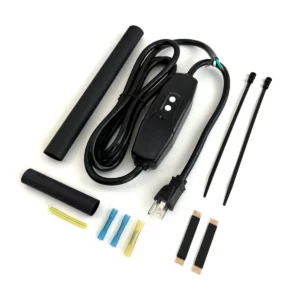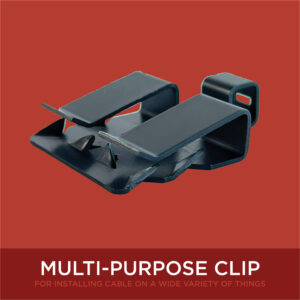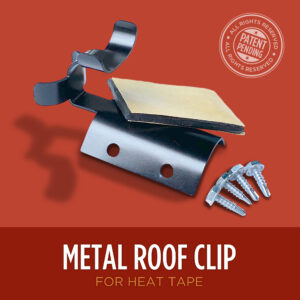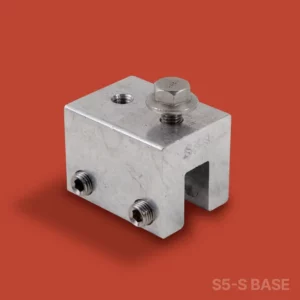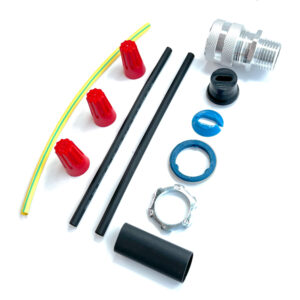The DDK-719 Heat Cable Roof Clip can be used to secure various brands of self-regulating heat tape on a variety of roofing materials including asphalt shingle roofs, standing seam metal roofs and rubber membrane roofs. It is designed with an oversized base to create a surface connection for glue that is superior to that of a standard clip. The versatility of this clip is a powerful tool in your Heat tape arsenal when installing your system to prevent Ice dams.
This is the Double Cradle version of this clip. Can be used in coordination with the single-cradle version of this same heat Tape clip.
$21.00
3375 in stock

The Double-Cradle Oversized Heat Tape Roof Clip stands as a reliable and adaptable solution for securing self-regulating heat tape across diverse roofing materials. Its multifunctional design caters to various roof types, such as asphalt shingle roofs, standing seam metal roofs, and rubber membrane roofs. Specifically engineered with an oversized base, this clip surpasses the capabilities of standard clips by offering an unparalleled surface connection for glue application. This superior bonding quality ensures a steadfast and long-lasting attachment, making it an indispensable component in your arsenal for heat tape installation, effectively thwarting the formation of ice dams.
Moreover, the clip’s exceptional features extend beyond its basic functionality. Unlike conventional nail-on clips, this innovative device boasts an impressive 56 holes strategically positioned to maximize glue adhesion. This substantial increase from the typical 20 holes significantly enhances the grip and stability of the installation, reinforcing its reliability in securing the heat tape in place.
Furthermore, the enlarged base of the Double-Cradle Oversized Heat Tape Roof Clip is a game-changer in creating a robust bond with the roofing surface. With a base area exceeding two times that of standard clips, this amplified surface area ensures a more substantial and fortified connection. This expanded base not only reinforces the bond but also contributes to the clip’s resilience against adverse weather conditions, providing added security and longevity to your heat tape system.
“Heat Tape Pro did exactly what I needed it to do. Now I don’t have to worry about water leaking into my house, because I can tell when it’s working by the little light on the end of the cable.”
-Michael P.
Amazon Customer
“This heat tape works as advertised. It was delivered to me fast, and although it’s a little complicated to install, the documentation is good..”
-Shaun D.
Radiant Solutions Customer
“I install thousands of feet of heat tape every year. This is the best stuff I’ve found to protect my customers homes and give them the piece of mind they need.”
-Patrick B.
Professional Installer
These heat cable clips are designed for smooth or non-porous roofing materials like flat rubber membrane (EPDM), TPO, PVC, and certain metal surfaces where maximum glue-down strength is required. Because the base is oversized (3” × 3”), they offer exceptional holding power compared to standard nail-on roof clips.
Single-cradle clips hold one run of heat cable. Double-cradle clips secure two runs side by side in the same location. Use the double-cradle version when you’re running parallel cables, need extra anchoring strength in high-load areas, or want to reduce the total number of adhesive-mounted clips on a project.
Because these roof clips are primarily used on flat and low-slope roof de-icing systems, the clip count depends on the layout. As a general rule, support your heat cable every 30-36 inches. With double-cradle clips, you may end up needing fewer total clips since each one can hold two runs. Sketching your layout on paper before installation will help you plan your clip count.
Double-cradle oversized clips provide the same oversized 3” × 3” base and 56 adhesive ports as the single-cradle, but with two cable cradles instead of one. This doubles the cable capacity per clip while maintaining the same strong adhesive bond. It’s a more efficient option when running parallel roof de-icing cables or reinforcing high-stress sections.
Use SB-190 adhesive (available from Radiant Solutions and other roofing suppliers). The oversized base and multiple holes allow the glue to flow through and cure into a permanent bond. Allow adequate cure time before loading the clip. Avoid generic construction adhesives, which can fail in freeze-thaw conditions.
Yes. Oversized double-cradle heat cable roof clips are designed for Heat Tape Pro and other self-regulating roof de-icing cables in the 5-6 mm × 8-13 mm size range. Each cradle holds one cable securely without pinching or damaging it.
No. Oversized roof clips bond with adhesive rather than nails or screws (though they can be fastened with nails and screws if you want). The large clip base spreads the load and provides a secure hold without penetrating the roof surface.
They’re engineered for long-term performance. The oversized adhesive base holds firm through wind, snow slides and freeze-thaw cycles. Properly installed with SB-190, oversized double-cradle heat tape clips will last for many years.
Choose the double-cradle version when you need to run two cables side by side, such as at the bottom of a zig-zag heat trace design. The double-cradle heat cable clip is also great for creating a butterfly cable pattern around roof drains and scuppers on membrane projects.
Not once the adhesive has cured. These clips are intended as permanent. If adjustments are needed, reposition before the adhesive sets. The best practice is to finalize your layout before securing any roof de-icing cable clips.
We keep them in stock and ship same day from Minnesota, don’t ‘cha know (assuming you don’t order too late in the day!). Orders placed over the weekend will ship the next business day.
Easy. Click here to view the spec sheet.
PipeFreezePRO comes with one or more 30ft rolls of high-quality fiberglass tape, but you can use any tape with a temperature rating of 150º F and above. Self-adhesive aluminum foil tape can be used but avoid standard tapes, including electrical tape and duct tape because they lose their adhesion when exposed to heat. Remember, it’s imperative to cover the pipe/heat tape assembly with pipe insulation (1/2″ minimum thickness). Think four easy steps: 1) cable on pipe, 2) tape on cable, 3) insulation on pipe/cable and 4) tape on insulation.
Pipe Freeze PRO can be overlapped during installation. This is a fundamental advantage of self-regulating heat cable over cheap, constant wattage cable found in hardware stores is that it can be overlapped without risk of shorting out or catching fire. So yes, overlap away!
The amount of heat cable needed for pipe freeze prevention is determined by a couple of simple factors including: Length of pipe, diameter of pipe, distance to power supply and number of valves.
Most of the time, we do not recommend a spiral cable application because it’s simply not necessary. It requires 3x the cable to do the same job.
Therefore, simply use a straight, single run of cable affixed to the bottom of the pipe (think 6 o’clock position) using the provided fiberglass installation tape. Next, add 1 foot of cable for every valve because you will be wrapping the valve with cable. For pipes less than 1″ in diameter, a single cable run is sufficient. For larger pipes, two cable runs are recommended. Keep in mind that plastic pipes are less thermally conductive so you may choose to use two cable runs on larger plastic pipes to be safe. Finally, if your outlet isn’t close to the pipe you are treating, factor in enough heat cable to reach your outlet (Pipe Freeze PRO does come with a 36″ power cord).
Finally, you must install insulation on your pipe and heat cable assembly in order for the system to operate effectively. See instructions for further details.
The cable can be exposed to wetness but the thermostat must stay dry to function properly. Use Pipe Freeze PRO for pipe freeze prevention applications only.
Consider using Heat Tape Pro inside of open drain pipes as that cable is rated for use in wet areas.
We are frequently restocking products and the one you need will soon be available. You can make a request to be notified when out of stock items are re-stocked.
Click Here to Submit your information to be notified of a Products Restock
Heat Tape Pro has the most comprehensive installation system that works on almost any kind of roof type.
For information about installing Heat Tape Pro on a Natural Slate Roof, Click here.
For information about installing Heat Tape Pro on a Synthetic late Roof, Click here.
Pipe Freeze Pro’s integrated thermostat turns power on and off automatically to the cable to save electricity. The thermostat is the lump located between the power cord and the heat cable. The thermostat triggers the cable to turn on at 37ºF and off at 50ºF, with a sensitivity range of +/- 4ºF. It’s a great feature that makes Pipe Freeze Pro unique among heat cables on the market.
Yes and no. The cable is approved for exposure to wet conditions but you should keep the thermostat dry for proper operation.
No. The thermostat need only be exposed to cold air. It does not hurt to have the thermostat attached to the pipe but it is not necessary. If you choose to attach it to the pipe keep in mind that the thermostat should not be covered with insulation.
No. You want the thermostat to react to the cold environment so it triggers the Pipe Freeze Pro to turn on.
Every Length of Heat Tape Pro has a cord length of 10-feet that is not included in the listed/state length. Meaning: A 100-foot Heat Tape pro will have a 100 feet of heated cable + a 10-foot unheated power cord.
Every Length of Pipe Freeze Pro has a cord length of 3-feet (36″) that is not included in the listed/state length. Meaning: A 30-foot Heat Tape pro will have a 30 feet of heated cable + a 3-foot unheated power cord.
Radiant Solutions has the most comprehensive installation system for Heat Tape that exists. We make accessories to install heat tape on almost any kind of roof.
Click here to learn about product specifically for Natural Cedar Roofs
Check out our full list of Frequently Asked Questions on our FAQ Page.
Take a Look at Our Heat Tape Installation Case Studies
Learn a Bit about Ice Dams and How & Why they Form
